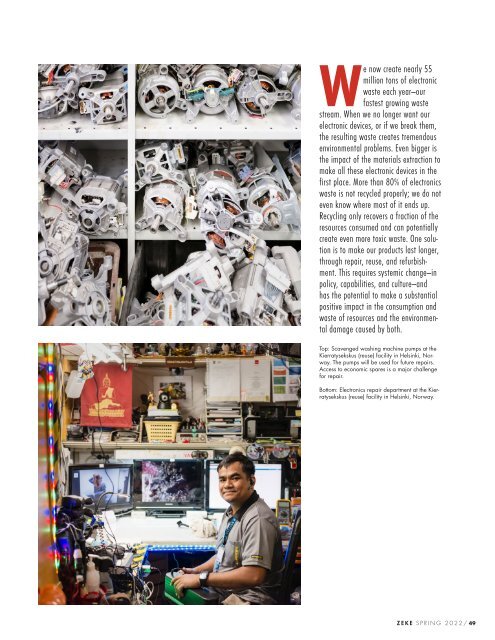ZEKE Magazine: Spring 2022
Sustainable Solutions to the Climate Crisis Indigenous Fire by Kiliii Yuyan The Indigenous Peoples' Burn Network is training others in an ancient technique of ecological restoration, which is to safely light low-intensity fires in wet seasons that remove the small fuels on the forest floor. Nemo's Garden by Giacomo d'Orlando Nemo’s Garden—the world’s first underwater greenhouses of terrestrial plants—represents an alternative farming system dedicated to those areas where environmental conditions make the growth of plants almost impossible. Permagarden Refugees by Sarah Fretwell The Palabek refugee settlement in Northern Uganda, with the staff of African Women Rising’s (AWR) Permagarden Program, works with refugees to utilize the existing resources—seeds, rainfall, limited land, and “waste”—and together build an agriculture system designed to help the environment regenerate and get stronger as it matures. Sustainable Solutions to the Climate Crisis by Antonia Juhasz Interview with Kiliii Yuyan by Caterina Clerici Dispatches from Ukraine by Maranie Staab Book Reviews Edited by Michelle Bogre
Sustainable Solutions to the Climate Crisis
Indigenous Fire by Kiliii Yuyan
The Indigenous Peoples' Burn Network is training others in an ancient technique of ecological restoration, which is to safely light low-intensity fires in wet seasons that remove the small fuels on the forest floor.
Nemo's Garden by Giacomo d'Orlando
Nemo’s Garden—the world’s first underwater greenhouses of terrestrial plants—represents an alternative farming system dedicated to those areas where environmental conditions make the growth of plants almost impossible.
Permagarden Refugees
by Sarah Fretwell
The Palabek refugee settlement in Northern Uganda, with the staff of African Women Rising’s (AWR) Permagarden Program, works with refugees to utilize the existing resources—seeds, rainfall, limited land, and “waste”—and together build an agriculture system designed to help the environment regenerate and get stronger as it matures.
Sustainable Solutions to the Climate Crisis
by Antonia Juhasz
Interview with Kiliii Yuyan by Caterina Clerici
Dispatches from Ukraine by Maranie Staab
Book Reviews Edited by Michelle Bogre
Create successful ePaper yourself
Turn your PDF publications into a flip-book with our unique Google optimized e-Paper software.
We now create nearly 55<br />
million tons of electronic<br />
waste each year—our<br />
fastest growing waste<br />
stream. When we no longer want our<br />
electronic devices, or if we break them,<br />
the resulting waste creates tremendous<br />
environmental problems. Even bigger is<br />
the impact of the materials extraction to<br />
make all these electronic devices in the<br />
first place. More than 80% of electronics<br />
waste is not recycled properly; we do not<br />
even know where most of it ends up.<br />
Recycling only recovers a fraction of the<br />
resources consumed and can potentially<br />
create even more toxic waste. One solution<br />
is to make our products last longer,<br />
through repair, reuse, and refurbishment.<br />
This requires systemic change—in<br />
policy, capabilities, and culture—and<br />
has the potential to make a substantial<br />
positive impact in the consumption and<br />
waste of resources and the environmental<br />
damage caused by both.<br />
Top: Scavenged washing machine pumps at the<br />
Kierratysekskus (reuse) facility in Helsinki, Norway.<br />
The pumps will be used for future repairs.<br />
Access to economic spares is a major challenge<br />
for repair.<br />
Bottom: Electronics repair department at the Kierratysekskus<br />
(reuse) facility in Helsinki, Norway.<br />
<strong>ZEKE</strong> SPRING <strong>2022</strong>/ 49
















